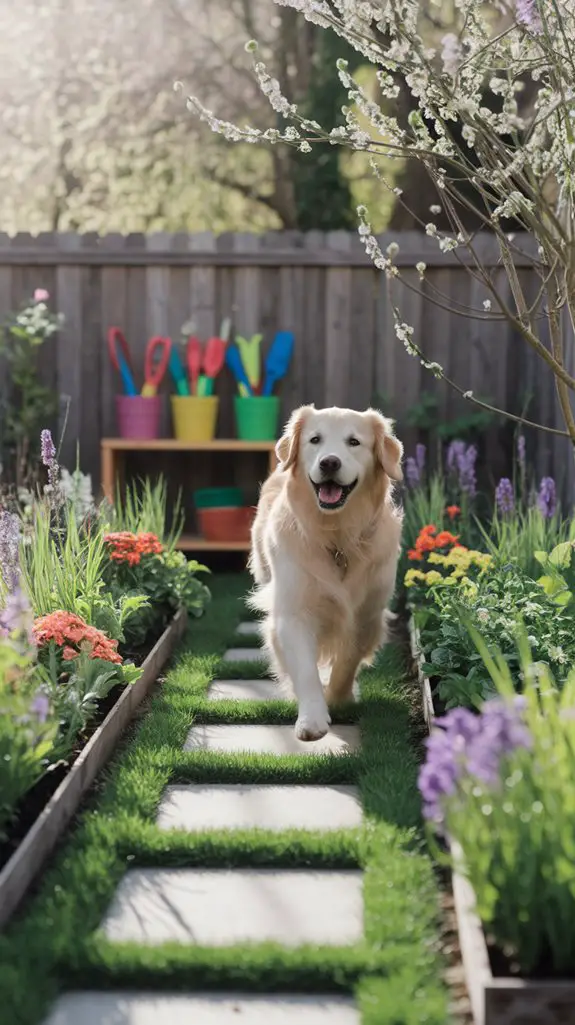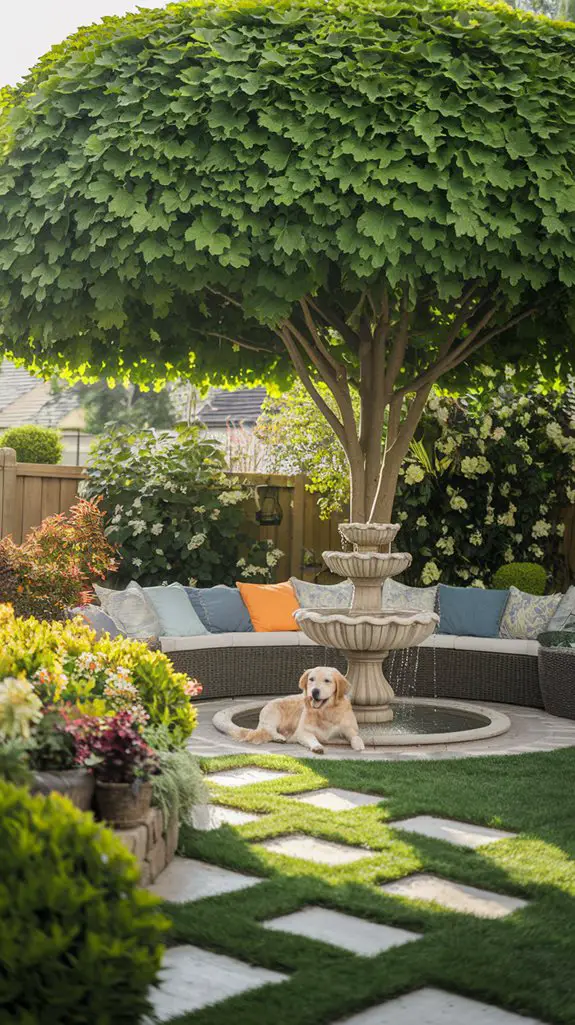Your backyard serves as a playground, a bathroom, and a territory for your pets throughout the changing seasons. You’ll need to make specific adjustments as temperatures rise and fall to keep your furry companions safe. Winter brings icy hazards, spring introduces toxic plants, summer creates heat risks, and fall presents hidden dangers beneath colorful leaves. Discover how to transform your outdoor space into a year-round sanctuary that protects your pets’ paws, bodies, and curious mouths.
Winter Precautions for Paw-Safe Backyard Surfaces
When winter’s freezing temperatures arrive, your pet’s paws require special protection from the hazards that develop in your backyard. Ice accumulation presents significant risks, causing painful cracks in paw pads and potential lacerations from sharp edges.
Avoid chemical de-icers containing calcium chloride or ammonium nitrate, as these substances cause chemical burns on contact and toxicity if ingested during post-walk grooming.
Instead, implement pet-safe alternatives such as sand or commercially available pet-friendly ice melts. Create designated snow-cleared pathways through your yard, approximately 2-3 feet wide, allowing your pet to exercise without prolonged exposure to freezing surfaces.
Install weather-resistant rubber mats near entrances to provide thermal barriers between paws and frozen ground. After outdoor activity, thoroughly dry paws with microfiber towels to remove ice particles and potential chemical residues. Additionally, consider incorporating shade solutions in your pet-friendly backyard to protect them from extreme weather conditions year-round.
Spring Planting Guide for Pet-Friendly Gardens

As spring temperatures rise and soil conditions improve, you’ll need to carefully select pet-compatible plants for your garden while eliminating common toxic varieties that pose serious health risks. Focus on cultivating sturdy, non-toxic perennials that can withstand occasional trampling and curious sniffing. Additionally, consider implementing natural pest control methods to keep your garden healthy without harming your furry friends.
| Safe Plants | Toxic Plants to Avoid |
|---|---|
| Sunflowers | Lilies (all varieties) |
| Marigolds | Azaleas/Rhododendrons |
| Catnip | Foxglove |
When designing beds, implement physical barriers like decorative fencing or stone borders to protect delicate seedlings from digging. Apply pet-safe fertilizers and avoid cocoa mulch, which contains theobromine that’s toxic to dogs when ingested. Remember to store gardening chemicals in locked cabinets, as curious pets may investigate open containers of fertilizers or pesticides.
Summer Shade and Cooling Stations for Your Pets

Summer temperatures can quickly become dangerous for pets, necessitating proper shade structures and cooling options throughout your yard.
Pets can suffer heat stroke when their body temperature exceeds 104°F, requiring immediate preventative measures in your outdoor space.
- Install portable canopies or shade sails strategically around your yard, ensuring coverage during peak sun hours (10 AM – 4 PM).
- Create a shallow wading pool (2-3 inches deep) in a shaded area, revitalizing water twice daily to prevent mosquito breeding.
- Position cooling mats on concrete surfaces that remain naturally cooler than surrounding areas.
- Construct a DIY misting station using PVC pipes with small drilled holes connected to your garden hose, activating during temperature spikes above 85°F.
Additionally, consider incorporating multi-functional pet-friendly spaces that allow your pets to enjoy the outdoors while staying safe from the heat.
Fall Cleanup Strategies to Keep Pets Safe
Fall yard maintenance presents several hazards for pets that require vigilant monitoring and strategic planning to prevent accidental harm. When raking leaves, guarantee your pet doesn’t ingest decomposing matter containing toxic molds or fungi. Secure compost piles with fencing to prevent access to spoiled foods and toxic plant material. Additionally, employing effective natural solutions can help keep your vegetable garden pest-free, which is beneficial for both your plants and pets.
| Hazard | Risk | Prevention Strategy |
|---|---|---|
| Fallen fruit | Fermentation toxicity | Remove promptly from ground |
| Rodenticides | Internal hemorrhaging | Use pet-safe alternatives |
| Mushrooms | Liver/kidney failure | Inspect yard daily, remove all |
Store landscaping chemicals in locked cabinets with proper ventilation. When applying fertilizers, keep pets off treated areas until completely dry—typically 24-48 hours. Remove lawn debris regularly, as piles can harbor parasites, snakes, and irritant plants that may cause dermatitis or respiratory issues.
Year-Round Toxic Plant Prevention for Pet Areas
Creating a pet-safe backyard environment requires vigilant monitoring of plant species throughout all seasons, not just during active growth periods.
Common landscape plants like azaleas, lilies, and oleander can cause severe toxicity in dogs and cats, while even dormant bulbs pose excavation hazards for curious diggers.
- Maintain a thorough inventory of existing plants, verifying toxicity status through veterinary poison control databases quarterly.
- Implement physical barriers around toxic specimens that can’t be removed, using 36-inch minimum fencing or dense companion planting.
- Establish designated “pet zones” with exclusively non-toxic vegetation, particularly in areas where animals frequently rest or play.
- Conduct weekly inspections for fallen seeds, fruits, or mushrooms that may appear spontaneously, especially following precipitation events.
Additionally, consider utilizing natural pest control methods to deter harmful insects that could affect both pets and plants.
Conclusion
Like a vigilant shepherd watching over their flock, you’re now equipped to guard your backyard kingdom against seasonal threats to your furry subjects. Your diligence in maintaining pet-safe surfaces, selecting non-toxic plants, creating cooling refuges, conducting thorough fall cleanups, and monitoring for toxic vegetation will transform your outdoor space into a sanctuary where your pets can thrive year-round.




